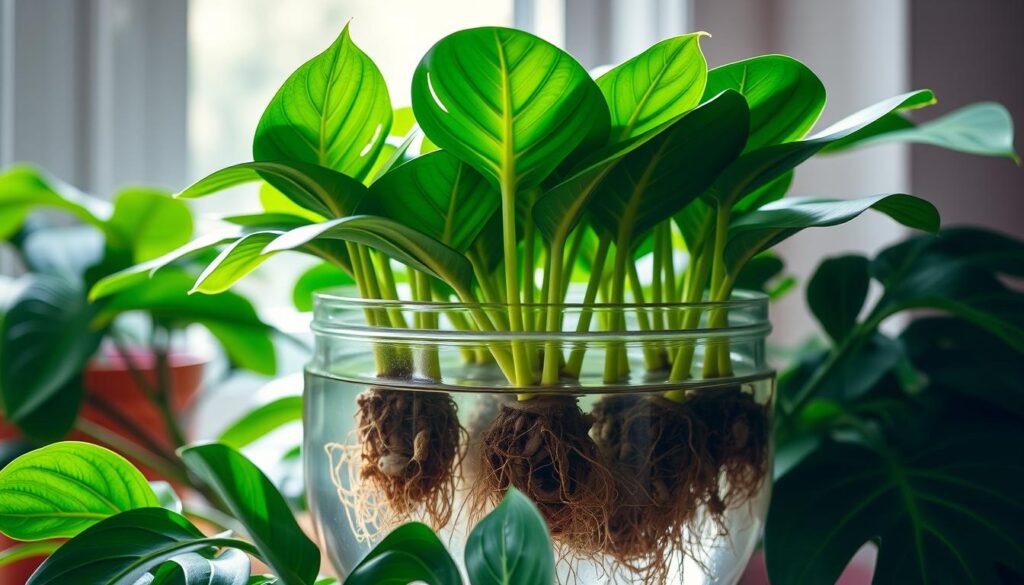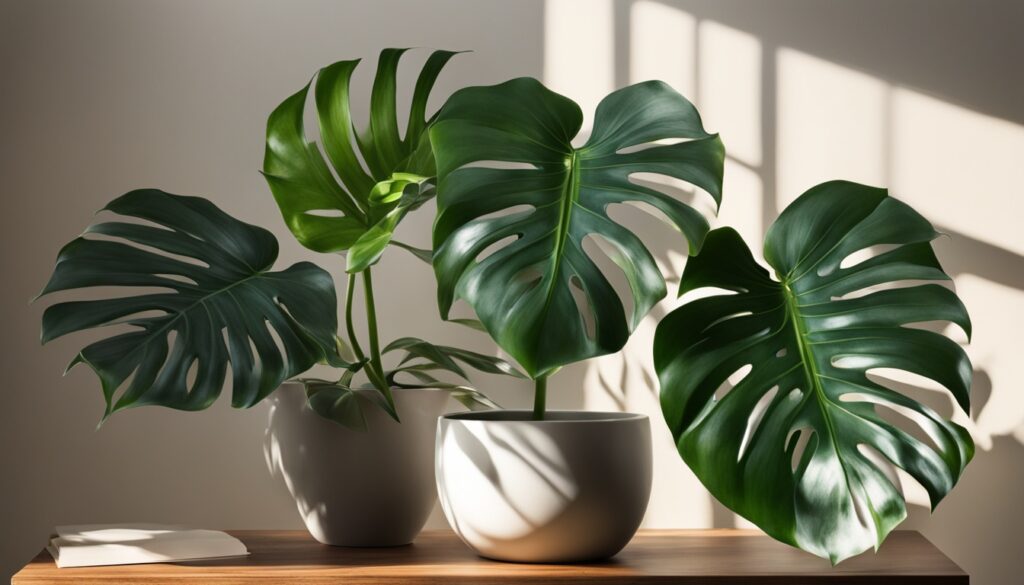Ever thought about growing more Monstera deliciosa plants without spending a lot? Good news! Propagating Monstera is a fun and cost-effective way to grow your indoor jungle. But, do you know the secret to successfully growing Monstera cuttings? Follow these easy steps to make your Monstera plants thrive.
Key Takeaways
- Monstera deliciosa can be propagated through stem cuttings, water propagation, or air layering methods.
- Identifying the right nodes and making clean cuts are crucial for successful Monstera propagation.
- Providing optimal growing conditions, such as warmth, humidity, and well-draining soil or water, is key to stimulating root growth.
- Monitoring the health of cuttings and addressing any issues promptly can enhance the chances of successful propagation.
- Patience is essential, as it can take 2-3 months for new leaves to form on Monstera cuttings.
Unlock the secrets to effortlessly multiplying your with this comprehensive guide. Discover the step-by-step methods that will have your new Monstera plants thriving in no time.
Understanding Monstera Deliciosa: A Quick Overview
Monstera deliciosa, also known as the Swiss cheese plant, comes from Central America’s lush rainforests. It has big, shiny green leaves with holes and deep cuts. This makes it stand out.
Key Characteristics of Monstera Plants
Monstera plants grow big and fast. They can get over 50 feet long, climbing up as they grow. At home, they need the right light to keep their leaves looking great.
Natural Habitat and Growth Patterns
Monstera deliciosa loves the shade and humidity of Central America’s rainforests. It’s perfect for indoor spaces because it doesn’t need much light. Even though they rarely bloom indoors, their beautiful leaves make them a favorite for homes and offices.
“Monstera deliciosa is one of the most sought-after houseplants, prized for its striking, perforated leaves and easy-going nature.”
It’s easy to see why Monstera plants are so popular. Their unique look and ability to thrive indoors make them a favorite among plant lovers.
Essential Tools and Materials for Propagation
Propagating the captivating Monstera plants needs a few key tools and materials. This ensures your efforts are successful. Whether you’re using water or soil, the right tools make it easier.
You’ll first need sharp scissors or pruning shears for clean cuts. For water propagation, a clean glass jar or container is a must. For soil, you’ll need well-draining potting soil and perlite or LECA.
Optional items can help too. Rooting hormone boosts root growth, plastic wrap aids in air layering, and a support stake helps with larger cuttings. Always sterilize your tools to avoid disease.
| Monstera Propagation Tools | Monstera Propagation Materials |
|---|---|
| Scissors or pruning shears | Glass jar or container |
| Rooting hormone (optional) | Well-draining potting soil |
| Plastic wrap (for air layering) | Perlite or LECA |
| Support stake | Sterilized tools |
With these monstera propagation tools and propagation materials, you’re ready to grow more Monstera plants. You’ll soon have a bigger collection.

Best Time to Propagate Your Monstera
The best time to propagate your Monstera is in the spring and summer. This is when the plant grows the fastest. Propagation during winter is not recommended because the plant is dormant then.
Seasonal Considerations
Timing is key for Monstera propagation. Spring and summer are the best times. The plant grows more during these seasons, making it easier to take root and grow new leaves.
Growth Cycle Impact
Think about your Monstera’s growth cycle before taking cuttings. Propagation in late fall or early winter might need extra light. It takes time for the cuttings to grow fully, so be patient.
| Propagation Timing | Root Development | New Growth |
|---|---|---|
| Spring/Summer | Faster | Quicker |
| Fall/Winter | Slower | Delayed |
Knowing when to propagate your Monstera can help you grow more plants. This way, you can expand your indoor garden.
https://www.youtube.com/watch?v=SZ8fwPB4Kq0
“Propagating Monstera plants during their active growing season is the key to achieving the best results. Be patient, and give your cuttings the time they need to develop strong, healthy roots.”
Identifying the Right Parts for Propagation
Starting a Monstera plant from cuttings requires the right parts. Look for the monstera nodes – small bumps on the stem where leaves grow. These nodes are vital for new growth. Make sure your cutting has at least one node.
Also, having monstera stem cuttings with aerial roots helps with rooting.
Don’t use just leaves or petioles for propagation. They won’t grow into new plants. Instead, choose healthy stems with 2-3 nodes. Include 1-2 leaves to help with photosynthesis during the rooting stage.
Getting the right cuttings is key to success. Focus on nodes and stem cuttings for the best results.
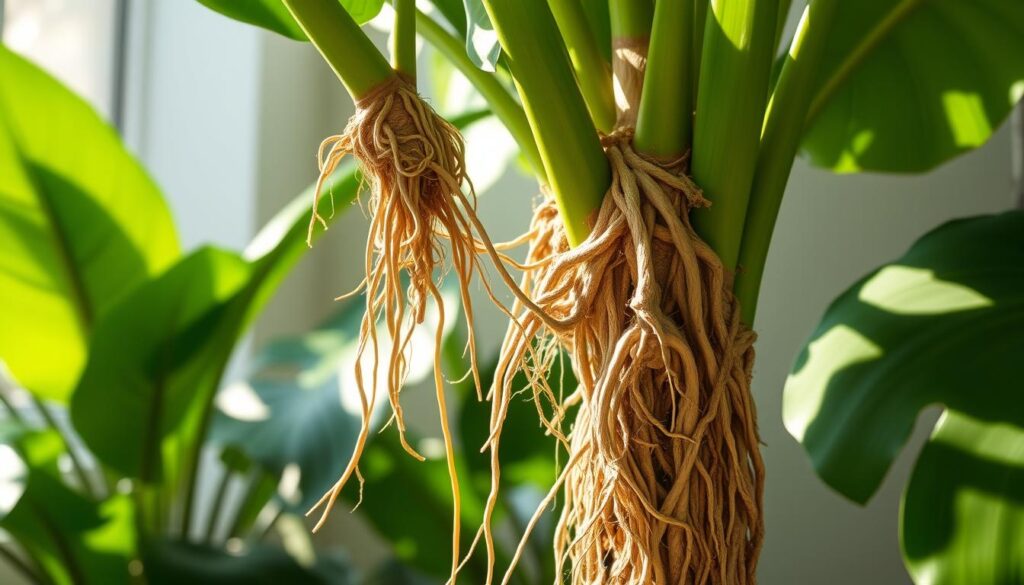
“A single Monstera plant can be propagated into five separate plants.”
| Propagation Method | Success Rate | Time to Root |
|---|---|---|
| Stem Cuttings | Moderate | 4-6 weeks |
| Air Layering | High | 4-8 weeks |
Understanding the role of monstera nodes and stem cuttings boosts your chances of success. Check out different propagation techniques to find what works best for you.
Monstera How to Propagate: Step-by-Step Guide
Finding and Preparing Nodes
To start, find a healthy stem with a node on your Monstera deliciosa. A node is where leaves or new growth appear. Look for a stem that’s strong and free of disease.
Use sharp, clean scissors or pruning shears to cut 1-2 inches below the node. Remove lower leaves, leaving 2-3 at the top. If using rooting hormone, apply it to the cut end and node(s) now.
Making the Perfect Cut
For propagating Monstera plants, a clean cut is key. The cut should be straight and smooth. This helps the cutting heal and grow roots.
- Use sharp, high-quality scissors or pruning shears to make the cut.
- Sterilize the blades before and after use to prevent disease spread.
- Cut the stem at a 45-degree angle, about 1-2 inches below the desired node.
- Ensure the cut is clean and smooth, with no jagged or crushed edges.
By following these steps, your Monstera cutting will have a good start in the propagation process.
“Water propagation typically takes 2-4 weeks for roots to grow on a Monstera cutting, while soil propagation may require a few weeks more.”
Water Propagation Method
Propagating your Monstera deliciosa using the water method is both popular and effective. It lets you watch your cuttings’ roots grow. This makes sure they’re ready to move to soil.
To start, fill a clean glass with room-temperature water. Place the node of your Monstera cutting in it. Change the water often to avoid bacteria. Roots should appear in 2 to 4 weeks.
The monstera water propagation method lets you see your cuttings grow. When the roots are 2-3 inches long, it’s time to move them to soil. This method might make the roots a bit weaker than those grown in soil.
“Propagating your Monstera in water is a rewarding way to expand your plant collection and share the beauty of these iconic leaves.”
Whether you’re new to plants or have experience, propagating monstera in water is easy and rewarding. With patience and the right care, you can grow a beautiful Monstera collection.
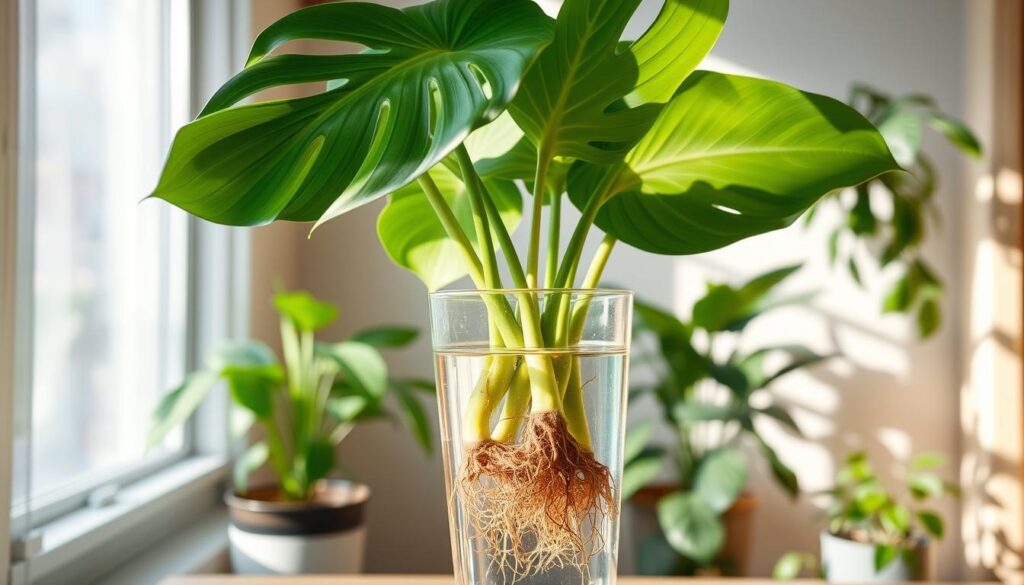
Soil Propagation Technique
Soil propagation is a great way to grow monstera plants, besides water. It helps create strong roots that are ready for soil when it’s time to move the plant. This method is effective for growing healthy monstera cuttings.
Soil Mix Requirements
For soil propagation, use a mix that drains well. Add perlite or LECA to the mix. This ensures good air and water flow, preventing root rot. Stay away from heavy garden soils that can block root growth.
Planting Depth Guidelines
Plant the monstera cutting so the node or aerial root is 1-2 inches deep. This helps the roots grow down. Make sure the stem and leaves stay above the soil. The right depth is key for the cutting to grow well.
Soil propagation works well for bigger cuttings or those with aerial roots. It offers a stable base for the roots to develop. With the right care and depth, your monstera will thrive.
Air Layering Method Explained
If you want to grow more Monstera Deliciosa, try air layering. This method lets you grow new plants from the parent plant. You don’t need separate containers or soil.
To start, make a small cut on the Monstera’s stem, just below a node. Then, wrap the area with moist sphagnum moss. Cover it with plastic wrap and secure it with twist ties. Roots will grow in the moss in 1-2 months. After that, you can cut the stem and pot the new plant in well-draining soil.
- Find a healthy, mature stem on your Monstera Deliciosa plant.
- Make a monstera air layering incision just below a node, 4-6 inches from the tip.
- Wrap the area with moist sphagnum moss, covering the incision.
- Use a clear plastic to cover the moss, securing it with twist ties or rubber bands.
- Keep the moss moist by misting it often, watching for root growth in 4-8 weeks.
- When roots are healthy, cut the stem below the new root ball. Then, pot the new air layering propagation in a good potting mix.
Air layering is easy for growing Monstera Deliciosa without extra containers or soil. It uses the parent plant’s resources to grow new plants with little effort.
“Air layering is a great propagation method for plants that don’t readily produce roots from cuttings, like Monstera Deliciosa.”
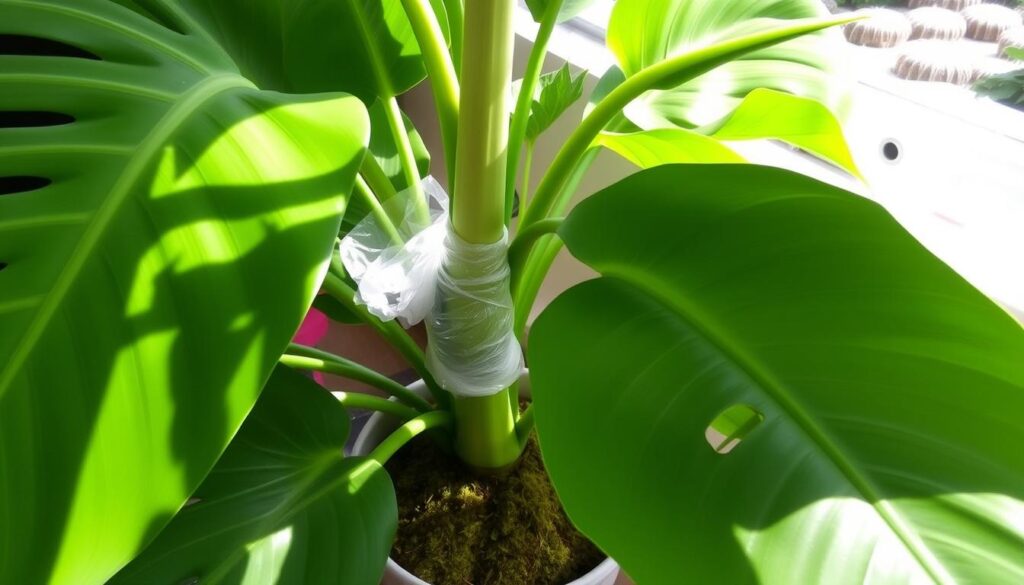
For successful monstera air layering, keep the root zone moist and provide the right conditions. With patience and care, you can multiply your Monstera collection using this unique technique.
Creating Optimal Growing Conditions
Getting the right environment is key for growing your monstera cuttings well. Light, temperature, and humidity are all important. Each one helps your new plants grow strong and healthy.
Light Requirements
Monstera cuttings love bright, indirect light. Don’t let them get direct sunlight, as it can burn their leaves. Instead, give them a spot with lots of natural light that’s not too harsh.
Temperature and Humidity Needs
Keep your monstera cuttings in a spot with a temperature between 65-85°F (18-29°C). Make sure it’s not too hot or cold. Also, keep the humidity up by misting the leaves or using a pebble tray. This helps them feel like they’re back in the tropics.
- For soil propagation, keep the soil moist but not soggy.
- Using a heat mat can help the roots grow faster.
“Propagating a monstera plant can be a slow process but rewarding in the end.”
By making the right growing conditions, you’ll help your monstera propagation succeed. This way, you’ll get healthy, beautiful plants to enjoy for a long time.
Common Propagation Problems and Solutions
Propagating Monstera plants can be rewarding but comes with challenges. Growers might face issues like rotting stems, slow root growth, and yellow leaves. Knowing these problems and their fixes can help you grow a healthy Monstera collection.
Stem rot is a common issue in monstera propagation. It happens when you water too much or the soil doesn’t drain well. To avoid rot, use a well-draining medium and don’t let cuttings sit in water. If rot appears, cut off the bad parts and repot in fresh soil.
Slow root growth can be a problem too. It might be because of too little light or cold temperatures. Make sure your cuttings get bright, indirect light and stay warm. Remember, propagation can take weeks to show results.
- Rotting stems can be prevented by ensuring proper drainage and avoiding overwatering.
- Slow root development may be due to low light or cool temperatures. Provide bright, indirect light and maintain a warm environment.
- Yellowing leaves can indicate overwatering or nutrient deficiencies. Adjust your watering and fertilization practices accordingly.
Leaf yellowing is another issue, often from too much water or lacking nutrients. Keep a close eye on your Monstera cuttings. Adjust how often you water and fertilize them. With the right care, you can solve these monstera propagation issues and enjoy your monstera cuttings.
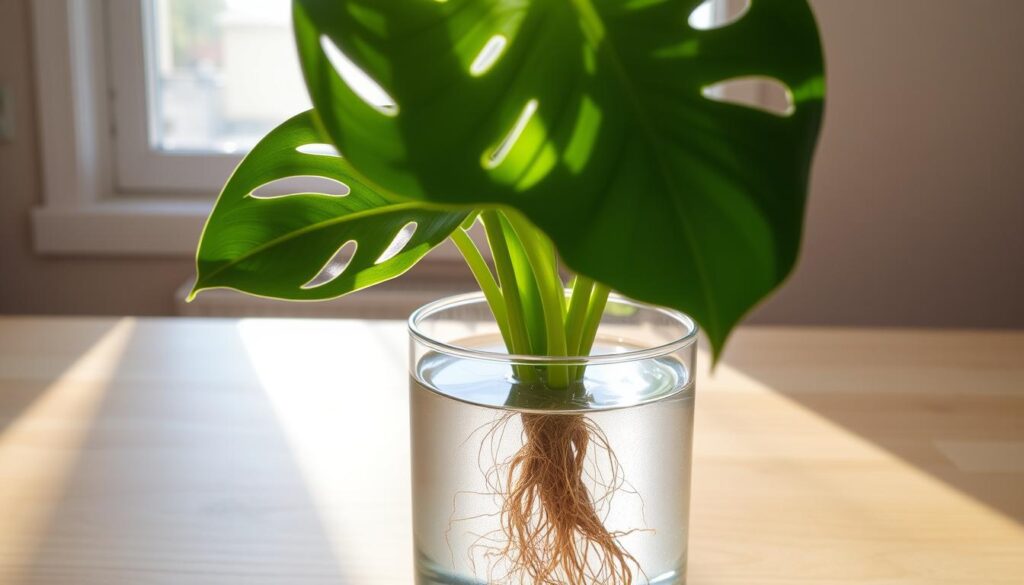
“Patience and attention to detail are key when propagating Monstera plants. With the right care, you can overcome common challenges and enjoy the rewards of a thriving collection.”
Signs of Successful Root Development
Seeing your Monstera deliciosa plants grow healthy roots is key. It shows your new Monstera is on the right path. Knowing when to transplant is crucial for its success.
Root Growth Stages
In water, roots start growing in 2-4 weeks. They’ll be white, firm, and get longer. For soil, check for resistance after 3-4 weeks to see if roots are growing.
When to Transplant
Move water-propagated cuttings to soil when roots are 2-3 inches long. For soil, transplant when new leaves grow and roots show through holes.
Watching for signs of monstera root development helps your plants grow strong. This ensures they thrive from the start.
“Successful Monstera propagation is all about timing – waiting patiently for those first signs of root growth before transplanting to the next stage.”
Knowing when to transplant your Monstera cuttings is important. It helps your new plants grow well.
Caring for Your Newly Propagated Monstera
Congratulations on successfully propagating your new Monstera plant! Now, it’s time to give it the right care. Follow a few simple steps to help your monstera cutting care and new monstera plant care go smoothly.
First, put your Monstera in a spot with bright, indirect light. They like dappled sunlight, not direct sunlight. Water when the top inch of soil feels dry. Also, get your plant used to lower humidity if it was in a humid place.
About 4-6 weeks after transplanting, start feeding your Monstera with a balanced fertilizer. This will help it grow. Watch for pests or diseases and fix any problems quickly to keep your plant healthy.
As your Monstera gets bigger, it might need support for its vines. Use stakes or trellises to help it grow. With the right care, your Monstera will grow well and look great.
For more tips on houseplants, check out our detailed guides and resources.
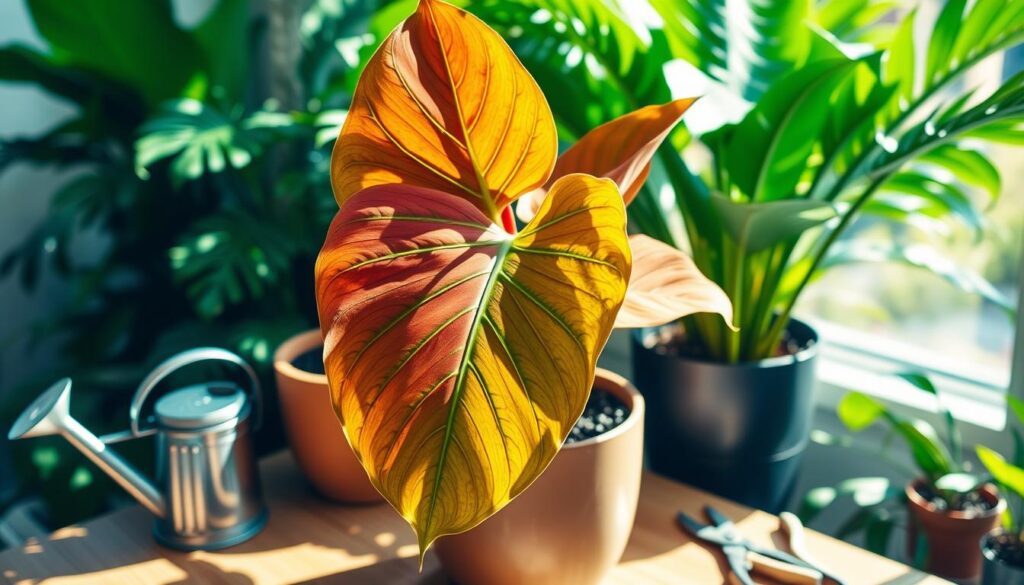
“Proper care and attention are the keys to a thriving, long-lasting Monstera plant.”
Special Considerations for Variegated Monstera
Propagating variegated monstera varieties like ‘Thai Constellation’ and ‘Albo Borsigiana’ needs extra care. These plants are prized for their unique leaf patterns. They grow more slowly because they have less chlorophyll.
To keep the vibrant variegation, make sure the cutting has some variegated leaves. Variegated Monsteras are more sensitive to light. They may need slightly lower light to avoid leaf burn.
Be patient when propagating these special variegated monstera plants. The cuttings may take longer to root and grow compared to non-variegated ones.
Variegation Patterns and Rarity
The variegated monstera ‘Variegata’ is rare. It can show random variegation in any color or pattern. The ‘Albo Borsigiana’ variety is famous for its striking white variegation, sometimes with half-moon or full moon foliage.
The Monstera ‘Thai Constellation’ is sought after for its cream-colored speckled leaves. The ‘Mint Variegata’ is known for its minty green and white variegation. It’s a rare find for many plant lovers.
The ‘Aurea’ variant has yellowish variegation. Some specimens show less intense color. Experts suggest removing full moon leaves. They can’t photosynthesize well and drain the plant’s energy.
“Variegated Monsteras are more sensitive to light and may require slightly lower light levels to prevent leaf burn.”
Keeping the right light conditions is key for these unique Monstera plants. They need bright, indirect sunlight but should be protected from harsh direct rays. This balance is crucial for their healthy growth and vibrant foliage.
Pruning and Maintenance After Propagation
After your monstera plant is settled, regular pruning is key. It keeps the plant looking good and growing bushier. Prune your monstera in spring or early summer when it’s growing fast.
Remove yellow or damaged leaves and trim long stems. Use sharp scissors or shears to cut just above a node. Adding support, like a moss pole, helps shape your monstera as it grows.
Shaping Your New Plant
Pruning helps shape your monstera into what you want. By cutting back some growth and guiding the vines, you get a fuller, balanced look. Prune during the growing season for the best results.
Ongoing Care Requirements
Keeping your monstera healthy also means regular watering, fertilizing, and watching for pests. Repot every 1-2 years or when the roots fill the pot. These steps help your plant stay healthy and grow well.
For tips on ZZ plants, another low-maintenance houseplant, see our detailed guide.
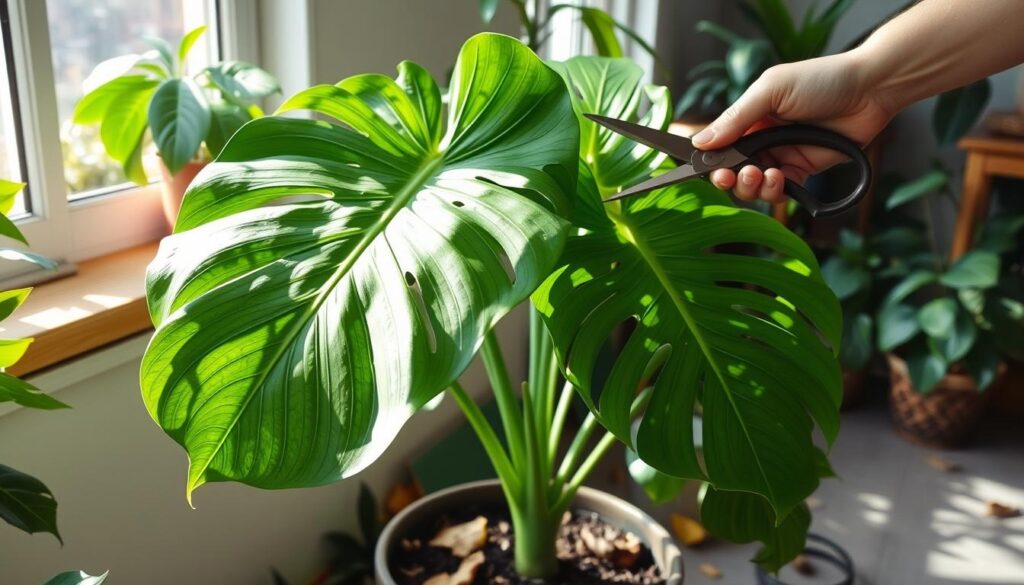
“Pruning is an essential part of monstera maintenance, allowing you to shape the plant and encourage a lush, healthy appearance.”
Tips for Successful Propagation
Start by using clean, sterile tools to avoid diseases. Choose healthy parent plants and cuttings with multiple nodes for better success. Keeping the environment moist and humid is key during rooting.
Patience is key when propagating Monstera cuttings. Some may take longer to root. Try water and soil propagation to see what works best for you. Keep the plants away from drafts and temperature changes for best growth.
Propagating multiple Monstera cuttings at once can boost your success rate. This way, you get more chances to grow new plants. You can also see how each cutting grows differently. Follow these tips to grow your Monstera plants successfully.
